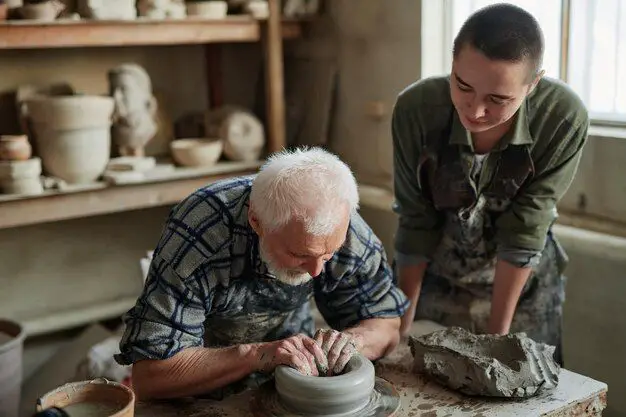What Is A Ceramic Spoon Used For?
Ceramic spoons are an increasingly popular type of spoon made from non-porous, non-metal materials like clay, bone china, or porcelain. They have an ancient history, dating back to the first spoons used by humans which were carved from materials like wood, bone, and stone. Ceramic spoons offer a smooth, durable surface for cooking and eating. They are made by shaping clay or porcelain materials into a spoon shape, applying a glaze if desired for appearance and surface properties, and then firing the spoons at high temperatures in a kiln to harden and set them.
Unlike metal spoons, ceramic spoons are generally poor conductors of heat which allows them to remain relatively cool compared to the temperature of the food being served. The non-porous glazed surface makes ceramic spoons resistant to staining and helps them maintain a clean, bright appearance with proper care. While metal spoons can sometimes leave an unpleasant metallic taste, ceramic spoons are inert and do not alter the flavor of foods. With their light weight and smooth surfaces, ceramic spoons offer a pleasant mouthfeel and complementary pairing with a wide variety of cooked and raw foods.
Benefits of Ceramic Spoons
Ceramic spoons offer several advantages over metal or plastic spoons:
Non-Reactive
Ceramic is non-porous and does not react with acidic foods like tomatoes or citrus. This prevents the spoon from imparting metallic flavors into foods.
Durable
High-quality ceramic is very durable and resistant to cracks or chips. Ceramic spoons can withstand repeated dishwasher cycles without damage.
Eco-Friendly
Ceramic spoons are made from natural clay materials and do not contain bisphenol A (BPA) or other harmful chemicals. They are generally more eco-friendly than plastic spoons.
Heat Resistant
Ceramic is able to withstand very high temperatures, so ceramic spoons can be used for cooking tasks like stirring hot liquids. They do not melt or warp under heat like plastic spoons can.
Common Uses
Ceramic spoons are a versatile kitchen utensil used for cooking, mixing, serving, and eating. Their smooth, non-porous surface makes them ideal for stirring sauces, mixing batters, and serving soft or liquid foods without scratching pans or bowls.
During cooking, ceramic spoons can be used to stir and mix ingredients in pots and pans on the stove or in the oven. Their heat resistance allows them to be used at high temperatures without warping or melting. When making sauces, stews, curries, or soups, a ceramic spoon is useful for preventing scorching and evenly distributing flavors.
For baking tasks like making cake batters, cookie dough, or bread doughs, ceramic spoons smoothly incorporate ingredients without tearing or over-mixing delicate batters. Their lightweight design gives cooks precision and control when folding and stirring.
At the table, ceramic spoons work well for serving and eating foods like ice cream, yogurt, cereals, and soups. Their smooth surfaces do not retain flavors or odors, so using the same ceramic spoon for different foods or courses is hygienic.
With their versatility from prep to table, ceramic spoons are one of the most useful utensils to have in any kitchen.
Types of Ceramic Spoons
There are several main types of ceramic spoons that each have their own unique properties and uses:
Glazed Ceramic: Glazed ceramic spoons have a glossy, glass-like coating applied to the surface. This makes them smooth, non-porous, easy to clean, and resistant to staining. Glazed ceramic is durable and holds up well to frequent use and washing.
Unglazed Ceramic: Unglazed (or biscuit) ceramic has a matte finish without a glaze coating. It’s slightly more porous than glazed ceramic. Unglazed spoons can develop a natural patina over time but are prone to more staining. They have an artisanal, handcrafted look.
Porcelain: Porcelain spoons are a type of ceramic made from finer clay and fired at high temperatures. This makes them very smooth, non-porous, and durable. Porcelain spoons are chip and stain resistant and ideal for daily use. They have a bright white appearance when glazed.
Stoneware: Stoneware is a dense, vitrified ceramic that can be glazed or unglazed. It’s impervious to liquids and can withstand high temperatures. Stoneware spoons tend to have a heavier, sturdier feel compared to porcelain. They come in natural clay colors or vivid glazes.
Design and Shape
Ceramic spoons come in a wide variety of shapes and decorative styles to suit different needs and tastes.
The most common ceramic spoon shapes include:
- Round/Oval – This classic spoon shape works well for most foods. The rounded bowl holds liquid and loose foods easily.
- Teaspoon – Longer and thinner than a traditional spoon, the teaspoon’s shape makes it ideal for stirring hot drinks like tea, coffee, or cocoa.
- Long handled – Some ceramic spoons feature an extra long handle, which provides a better grip and protects hands from hot foods.
- Spade or oval – This flat, broad shape works nicely for eating desserts like ice cream or pudding.
- Ladle – Ceramic ladles have a deep bowl and curved lip design perfect for serving soups or stews.
Decorative ceramic spoons add visual appeal to place settings. Popular styles include:
- Painted – Floral patterns, designs, and colors painted on the handle and/or bowl.
- Etched – Delicate etching creates texture and designs on the spoon’s surface.
- Jeweled – Simulated or genuine gemstones added to the handle for sparkle.
- Nature motifs – Featuring carved or molded animals, leaves, shells, or flowers.
The range of ceramic spoon shapes and designs allows finding the perfect option for individual preferences and serving needs.
Care and Cleaning
Ceramic spoons are very durable, but they still require some care when cleaning to avoid chips and cracks. Here are some tips for keeping ceramic spoons looking their best:
Most ceramic spoons are dishwasher safe. The high heat and pressure of a dishwasher is generally safe for ceramic and helps remove stuck-on foods. Just make sure to use a gentle cycle and allow plenty of space between items to prevent chipping.
When hand washing, use warm soapy water and a soft sponge or cloth. Avoid using abrasive scrubbers or steel wool, as these can scratch the glazed ceramic surface over time.
Do not expose ceramic spoons to any sudden temperature changes, like running hot spoons under cold water. This rapid change in temperature can lead to cracks or breaks. Allow spoons to cool gradually.
After washing, thoroughly dry ceramic spoons with a soft towel. Letting moisture air-dry can lead to mineral deposits building up over time.
With routine gentle cleaning and proper care, ceramic spoons can maintain their beauty and last for many years of cooking and eating.
Safety Tips
Ceramic spoons can be extremely durable, but they do come with some safety considerations. Here are a few tips for safely using ceramic spoons:
They can break if dropped – Ceramic is tough, but dropping it on a hard surface can cause chips, cracks, or breakage. Be careful when handling ceramic spoons and don’t drop them. Consider using wooden or carpeted flooring in areas where you use ceramic dishware.
Use caution when hot – Ceramic holds heat very well. Allow ceramic spoons to fully cool before touching them after taking them out of hot food or liquid. The glaze can make them seem cool when they are still hot inside. Let ceramic dishware return to room temperature before handling to avoid burns.
By following basic safety practices, ceramic spoons can be an extremely durable and safe kitchen tool. Handle them with care, allow cooling, and avoid drops to get the most longevity and safety from your ceramic spoons.
Cost
Ceramic spoons are generally more expensive than metal spoons. This is due to the cost of the materials and production process involved in making ceramic spoons. Ceramic clay, glazes, and the kiln firing required to produce ceramic items adds to the overall expense compared to stamping metal spoons.
However, ceramic spoons are extremely durable and last much longer than cheaper metal spoons. So while the upfront cost may be higher, a good ceramic spoon should provide years of reliable use, making it a valuable investment over time. The durability and longevity help offset the higher initial price tag.
When shopping for ceramic spoons, consider going for a high-quality brand known for craftsmanship and durability. This ensures you get maximum lifespan out of the spoon and makes the cost per use quite low. Cheaper ceramic spoons may be tempting but won’t stand up to repeated use. Spending a bit more on a sturdy, well-made ceramic spoon ends up being the better value.
Environmental Impact
One of the most notable benefits of ceramic spoons is their environmental impact compared to disposable plastic spoons. Ceramic is derived from natural clay materials, while most plastic spoons are made from petroleum-based chemicals. The production of ceramic spoons requires less energy and fewer resources than plastic.
Ceramic spoons are also reusable, unlike disposable plastics. A good quality ceramic spoon can last for many years with proper care, eliminating the need to constantly manufacture new spoons. This reduces plastic waste and your carbon footprint. Ceramic materials can also fully biodegrade at the end of their lifespan without leaving behind harmful microplastics.
Using reusable ceramic spoons is an easy way to make your kitchen more eco-friendly. Ceramic production has a lighter impact on the planet compared to plastics. And reducing disposables keeps waste out of landfills and oceans. With some care, ceramic spoons can provide years of sustainable use.
Conclusion
In summary, ceramic spoons offer several benefits that make them a popular kitchenware choice. They are made from natural clay materials that are non-toxic and generally safe to use with food. Ceramic spoons come in various shapes and sizes to suit different needs, from soups to baking. While more delicate than metal spoons, ceramic spoons can last a long time with proper care. The smooth glazed surface allows for easy cleaning. Ceramic spoons provide an attractive and colorful alternative to plain utensils. They are also appreciated by those following non-stick cooking practices or special diets that avoid metal. With proper use and handling, ceramic spoons can be a wonderful addition to any kitchen.




